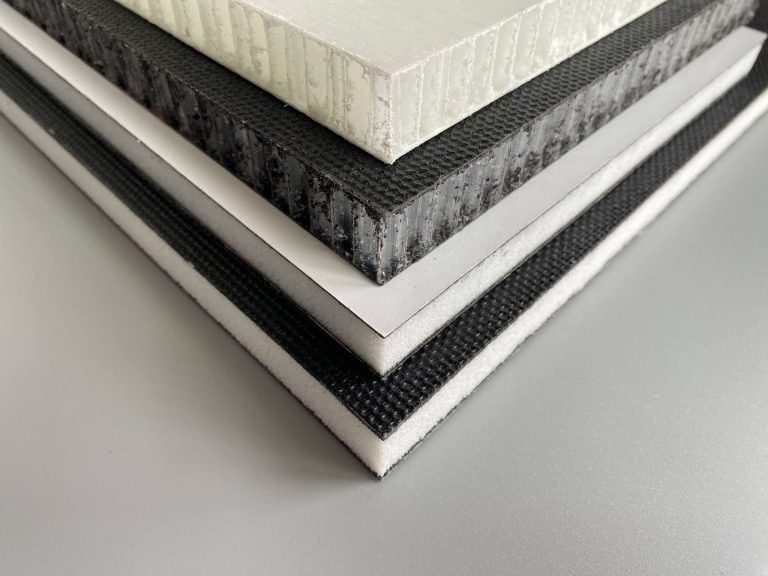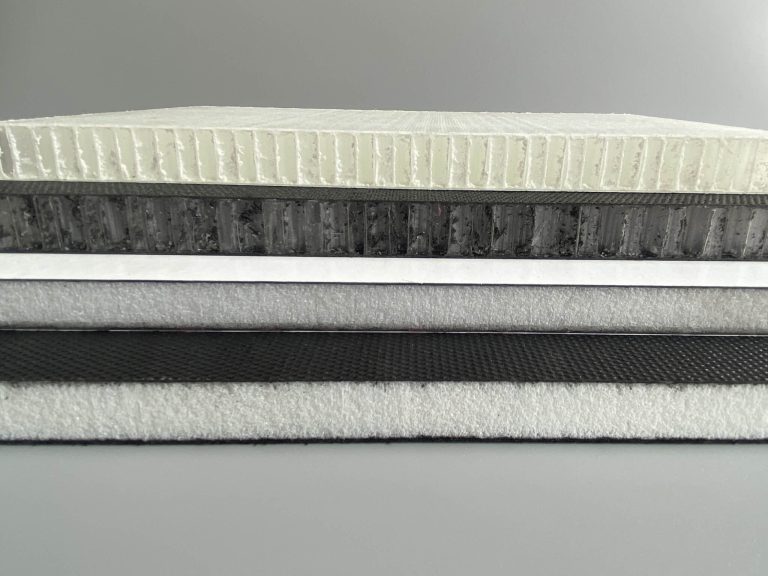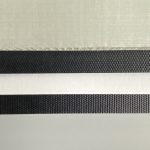Sandwich Panels
Glass Fiber Reinforced Plastic Sandwich Panels: The Industry’s Premier Solution
In the era of efficiency, sustainability, and durability, glass fiber reinforced plastic (GFRP) sandwich panels have emerged as the star choice across multiple industries. Whether you’re constructing scaffolding, mobile buildings, ocean-going vessels, cargo containers, or even refrigerated vehicles, these panels offer unparalleled advantages.
Sandwich Panel Structure
Sandwich panels, as the name suggests, are a type of panel with a sandwich-like structure, typically composed of three parts: a top skin, a core, and a bottom skin. While sandwich panels are a common type of panel structure, sandwich panels made of thermoplastic materials reinforced with glass fibers for the top and bottom skins, are a novel type of material. This type of sandwich panel is a core downstream product of continuous fiber-reinforced thermoplastic composites, fully demonstrating the core advantages of this innovative material. High strength and low weight are its fundamental characteristics.

Our Two Sandwich Panel Types
• PP Honeycomb Panels
PP honeycomb panels feature a honeycomb-like core made from polypropylene (PP), which offers exceptional strength and stiffness while being lightweight. This structure makes them ideal for applications requiring both durability and reduced weight.
• PET Foam Panels
On the other hand, PET foam panels utilize a core composed of polyethylene terephthalate (PET) foam, known for its excellent insulation properties and shock absorption capabilities. These panels are often chosen for their thermal insulation and soundproofing qualities, making them suitable for a wide range of applications from construction to automotive industries.
Both types of sandwich panels provide unique advantages tailored to specific needs.

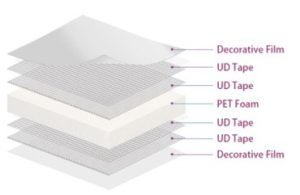
Specifications & Properties
• Specifications
- Thickness: From 6mm to 100mm, we offer a wide range of thicknesses to choose from. No matter what your project demands, we can tailor the perfect solution for you.
- Length: As our panels are produced continuously in the length direction and then cut to various lengths as required, theoretically, we can produce boards of any length.
- Width: The width of the panels is subject to the width limitation of our production equipment, and generally, we can produce boards with a width up to 2600mm.
- Core Density: Our panel cores come with various density options, ranging from 80 to 200 kilograms per cubic meter (Kg/m³), designed to cater to the needs of diverse application scenarios.
• Properties
The properties of sandwich panels are primarily reflected in aspects such as areal density, bending strength & modulus, bending stiffness, compressive strength, and impact resistance. In order to meet customers’ specific requirements for panel properties and cater to various application fields, we can design different panels by adjusting factors such as the number of skin layers, glass fiber content, resin type, and core material density.
The illustrative image shows test results of a 20mm honeycomb panel under impact. Despite visible dents on its surface, the panel remained intact without any cracks or fractures.
| Width (mm) | ≤2600 |
| Length (mm) | ≤120000 (According to container’s size) |
| Thickness (mm) | 5 – 100 |
| Core Density (Kg/m³) | 80/100/150/200 |


Sandwich Panel Main Features
- The glue-free hot-melt process of our sandwich panels is eco-friendly and emits zero harmful gases. By selecting them, you contribute to environmental protection.
- Carefully selected glass fiber-reinforced PP, and PET serve as the skin materials, guaranteeing exceptional strength and durability.
- The PP honeycomb structure boasts exceptional impact resistance, whereas the PET foam core excels in providing superb thermal insulation.
- These panels boast waterproof and mold-resistant properties, thereby offering safe and reliable protection even in high-humidity environments. Thanks to their unique material composition and processing techniques, they also exhibit outstanding corrosion resistance and decay prevention, enduring both indoor and outdoor conditions, as well as harsh chemical environments, to provide long-term stability and support for your projects.

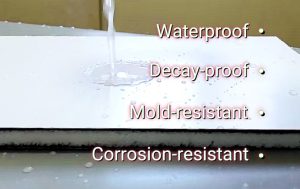
Sandwich Panel Versatility
The Sandwich Panel Versatility is remarkable, embracing a multitude of applications across various industries. From mobile scaffolding that supports construction projects to outdoor stages that host events, these panels are ideal choices. They serve as temporary fence panels ensuring security at various sites, while open trailers utilize them for efficient transportation. Courier vehicles rely on sandwich panels for sturdy delivery services, and racking and pallets made from these panels offer robust storage solutions. Enclosed trailers benefit from their durability and light weight, while recreational vehicles (RVs) incorporate them for comfortable travel and camping experiences. Additionally, pedestrian pathways utilizing sandwich panels provide safe and smooth walking areas, and fitness trails made from these panels encourage outdoor exercise and activity.
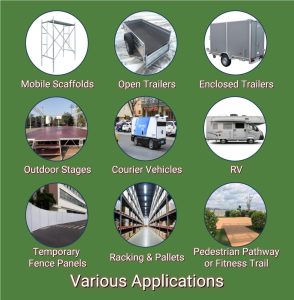
Discover PP Honeycomb & PET Foam Panels for Your Needs
Explore more about PP Honeycomb Panels and PET Foam Panels by clicking on the links. If you’re interested in incorporating these products into your scenarios, please reach out to us. We’re eager to hear from you!
